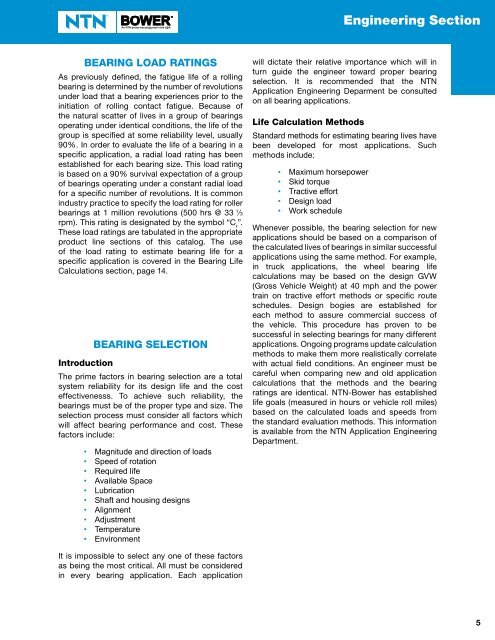Create successful ePaper yourself
Turn your PDF publications into a flip-book with our unique Google optimized e-Paper software.
Engineering Section<br />
BEARING LOAD RATINGS<br />
As previously defined, the fatigue life of a rolling<br />
bearing is determined by the number of revolutions<br />
under load that a bearing experiences prior to the<br />
initiation of rolling contact fatigue. Because of<br />
the natural scatter of lives in a group of bearings<br />
operating under identical conditions, the life of the<br />
group is specified at some reliability level, usually<br />
90%. In order to evaluate the life of a bearing in a<br />
specific application, a radial load rating has been<br />
established for each bearing size. This load rating<br />
is based on a 90% survival expectation of a group<br />
of bearings operating under a constant radial load<br />
for a specific number of revolutions. It is common<br />
industry practice to specify the load rating for roller<br />
bearings at 1 million revolutions (500 hrs @ 33 1 ⁄3<br />
rpm). This rating is designated by the symbol “C r<br />
”.<br />
These load ratings are tabulated in the appropriate<br />
product line sections of this catalog. The use<br />
of the load rating to estimate bearing life for a<br />
specific application is covered in the Bearing Life<br />
Calculations section, page 14.<br />
BEARING SELECTION<br />
Introduction<br />
The prime factors in bearing selection are a total<br />
system reliability for its design life <strong>and</strong> the cost<br />
effectivenesss. To achieve such reliability, the<br />
bearings must be of the proper type <strong>and</strong> size. The<br />
selection process must consider all factors which<br />
will affect bearing performance <strong>and</strong> cost. These<br />
factors include:<br />
• Magnitude <strong>and</strong> direction of loads<br />
• Speed of rotation<br />
• Required life<br />
• Available Space<br />
• Lubrication<br />
• Shaft <strong>and</strong> housing designs<br />
• Alignment<br />
• Adjustment<br />
• Temperature<br />
• Environment<br />
will dictate their relative importance which will in<br />
turn guide the engineer toward proper bearing<br />
selection. It is recommended that the <strong>NTN</strong><br />
Application Engineering Deparment be consulted<br />
on all bearing applications.<br />
Life Calculation Methods<br />
St<strong>and</strong>ard methods for estimating bearing lives have<br />
been developed for most applications. Such<br />
methods include:<br />
• Maximum horsepower<br />
• Skid torque<br />
• Tractive effort<br />
• Design load<br />
• Work schedule<br />
Whenever possible, the bearing selection for new<br />
applications should be based on a comparison of<br />
the calculated lives of bearings in similar successful<br />
applications using the same method. For example,<br />
in truck applications, the wheel bearing life<br />
calculations may be based on the design GVW<br />
(Gross Vehicle Weight) at 40 mph <strong>and</strong> the power<br />
train on tractive effort methods or specific route<br />
schedules. Design bogies are established for<br />
each method to assure commercial success of<br />
the vehicle. This procedure has proven to be<br />
successful in selecting bearings for many different<br />
applications. Ongoing programs update calculation<br />
methods to make them more realistically correlate<br />
with actual field conditions. An engineer must be<br />
careful when comparing new <strong>and</strong> old application<br />
calculations that the methods <strong>and</strong> the bearing<br />
ratings are identical. <strong>NTN</strong>-Bower has established<br />
life goals (measured in hours or vehicle roll miles)<br />
based on the calculated loads <strong>and</strong> speeds from<br />
the st<strong>and</strong>ard evaluation methods. This information<br />
is available from the <strong>NTN</strong> Application Engineering<br />
Department.<br />
It is impossible to select any one of these factors<br />
as being the most critical. All must be considered<br />
in every bearing application. Each application<br />
5

















